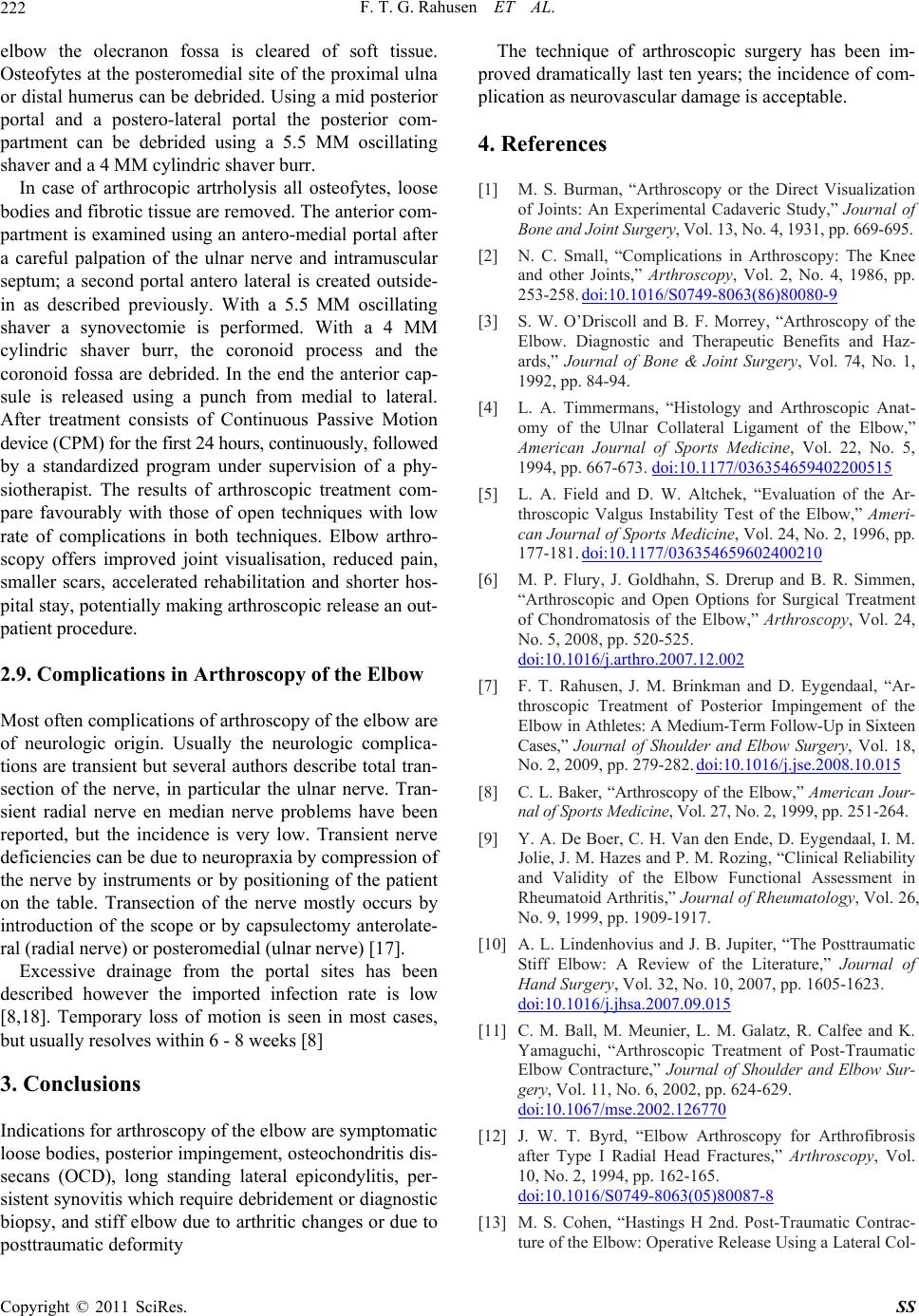
F. T. G. Rahusen ET AL.
222
elbow the olecranon fossa is cleared of soft tissue.
Osteofytes at the posteromedial site of the proximal ulna
or distal humerus can be debrided. Using a mid posterior
portal and a postero-lateral portal the posterior com-
partment can be debrided using a 5.5 MM oscillating
shaver an d a 4 MM cyl in d r ic s haver burr.
In case of arthrocopic artrholysis all osteofytes, loose
bodies and fibrotic tissue are removed. The anterior com-
partment is examined using an antero-medial portal after
a careful palpation of the ulnar nerve and intramuscular
septum; a second portal antero lateral is created outside-
in as described previously. With a 5.5 MM oscillating
shaver a synovectomie is performed. With a 4 MM
cylindric shaver burr, the coronoid process and the
coronoid fossa are debrided. In the end the anterior cap-
sule is released using a punch from medial to lateral.
After treatment consists of Continuous Passive Motion
device (CPM) for the first 24 hours, continuously, followed
by a standardized program under supervision of a phy-
siotherapist. The results of arthroscopic treatment com-
pare favourably with those of open techniques with low
rate of complications in both techniques. Elbow arthro-
scopy offers improved joint visualisation, reduced pain,
smaller scars, accelerated rehabilitation and shorter hos-
pital stay, potentially making arthro scopic release an out-
patient procedure.
2.9. Complications in Arthroscopy of the Elbow
Most often complication s of arthro scop y of the elbow ar e
of neurologic origin. Usually the neurologic complica-
tions are transient but several authors describe total tran-
section of the nerve, in particular the ulnar nerve. Tran-
sient radial nerve en median nerve problems have been
reported, but the incidence is very low. Transient nerve
deficiencies can be due to neuropraxia by compression of
the nerve by instruments or by positioning of the patient
on the table. Transection of the nerve mostly occurs by
introduction of the scope or by capsulectomy anterolate-
ral (radial nerve) or posteromedial (ulnar nerve) [17].
Excessive drainage from the portal sites has been
described however the imported infection rate is low
[8,18]. Temporary loss of motion is seen in most cases,
but usually resol ves wit hin 6 - 8 weeks [8]
3. Conclusions
Indications for arthroscop y of th e elbow are sy mpto matic
loose bodies, posterior impingement, osteochondritis dis-
secans (OCD), long standing lateral epicondylitis, per-
sistent synovitis which require d ebridement or diagnostic
biopsy, and stiff elbow due to arthritic chang es or due to
posttraumatic deformity
The technique of arthroscopic surgery has been im-
proved dramatically last ten years; the incidence of com-
plication as neurovascular damage is acceptable.
4. References
[1] M. S. Burman, “Arthroscopy or the Direct Visualization
of Joints: An Experimental Cadaveric Study,” Journal of
Bone and Joint Surgery, Vol. 13, No. 4, 1931, pp. 669-695.
[2] N. C. Small, “Complications in Arthroscopy: The Knee
and other Joints,” Arthroscopy, Vol. 2, No. 4, 1986, pp.
253-258. doi:10.1016/S0749-8063(86)80080-9
[3] S. W. O’Driscoll and B. F. Morrey, “Arthroscopy of the
Elbow. Diagnostic and Therapeutic Benefits and Haz-
ards,” Journal of Bone & Joint Surgery, Vol. 74, No. 1,
1992, pp. 84-94.
[4] L. A. Timmermans, “Histology and Arthroscopic Anat-
omy of the Ulnar Collateral Ligament of the Elbow,”
American Journal of Sports Medicine, Vol. 22, No. 5,
1994, pp. 667-673. doi:10.1177/036354659402200515
[5] L. A. Field and D. W. Altchek, “Evaluation of the Ar-
throscopic Valgus Instability Test of the Elbow,” Ameri-
can Journal of Sports Medicine, Vol. 24, No. 2, 1996, pp.
177-181. doi:10.1177/036354659602400210
[6] M. P. Flury, J. Goldhahn, S. Drerup and B. R. Simmen,
“Arthroscopic and Open Options for Surgical Treatment
of Chondromatosis of the Elbow,” Arthroscopy, Vol. 24,
No. 5, 2008, pp. 520-525.
doi:10.1016/j.arthro.2007.12.002
[7] F. T. Rahusen, J. M. Brinkman and D. Eygendaal, “Ar-
throscopic Treatment of Posterior Impingement of the
El bo w i n A t hletes: A Medium-T erm Foll ow-Up in Sixtee n
Cases,” Journal of Shoulder and Elbow Surgery, Vol. 18,
No. 2, 2009, pp. 279-282. doi:10.1016/j.jse.2008.10.015
[8] C. L. Baker, “Arthroscopy of the Elbow,” American Jour-
nal of Sports Medicine, Vol. 2 7 , N o. 2 , 1 9 9 9, pp. 251-264.
[9] Y. A. De Boer, C. H. Van den Ende, D. Eygendaal, I. M.
Jolie, J. M. Hazes and P. M. Rozing, “Clinical Reliability
and Validity of the Elbow Functional Assessment in
Rheumatoid Arthritis,” Journal of Rheumatology, Vol. 26,
No. 9, 1999, pp. 1909-1917.
[10] A. L. Lindenhovius and J. B. Jupiter, “The Posttraumatic
Stiff Elbow: A Review of the Literature,” Journal of
Hand Surgery, Vol. 32, No. 10, 2007, pp. 1605-1623.
doi:10.1016/j.jhsa.2007.09.015
[11] C. M. Ball, M. Meunier, L. M. Galatz, R. Calfee and K.
Yamaguchi, “Arthroscopic Treatment of Post-Traumatic
Elbow Contracture,” Journal of Shoulder and Elbow Sur-
gery, Vol. 11, No. 6, 2002, pp. 624-629.
doi:10.1067/mse.2002.126770
[12] J. W. T. Byrd, “Elbow Arthroscopy for Arthrofibrosis
after Type I Radial Head Fractures,” Arthroscopy, Vol.
10, No. 2, 1994, pp. 162-165.
doi:10.1016/S0749-8063(05)80087-8
[13] M. S. Cohen, “Hastings H 2nd. Post-Traumatic Contrac-
ture of the Elbow: Operative Release Using a Lateral Col-
Copyright © 2011 SciRes. SS